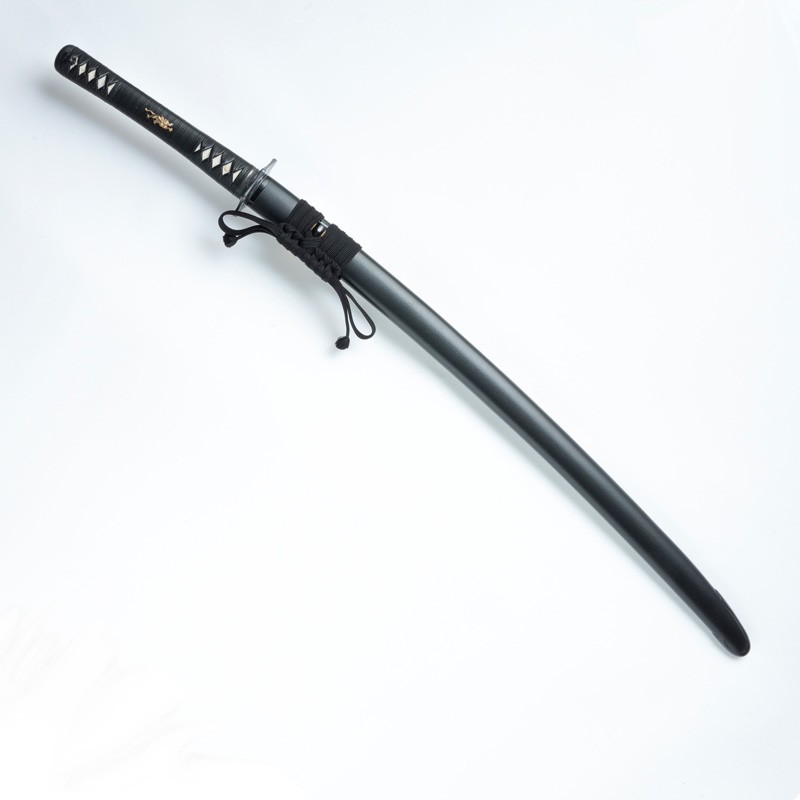














More informations about this product
The Toppei Koshirae 突兵拵 is a mount that dates from the time when the uniforms of the new Japanese army were adapted from French uniforms, in the mid 19th Century. The sword was then worn in the European style, threaded into a leather saber door during the belt. Worn almost vertically, the blades had to be shorter, the Saya Jiri was tapered and rounded at the end to fit into the sabre door leather gusset (leather frog).
The shape of the Saya, with a large Kojiri shaped like a long Hoe (Naga Kuwagata -長鍬形), is reminiscent of these cone-shaped helmets, the Toppai Kabuto. The ‘Hai’ became ‘Hei’, which gave the name of the Toppei Koshirae. As this type of frame was worn because of the wide pants, the name Zubon Koshirae (trouser frame) is also found.
The other feature is the braiding of the handle, the Tsuka Ito in Katate Maki. At the beginning and end of Tsuka we have Hineri Maki, revealing Same diamonds. In the center of the handle, the braiding is simply wound, without Same apparent, and with the Menuki in central position (Chuo).
This montage is the one used by Kirino Toshiaki, also known as Hanjirō Nakamura, one of the 4 Hitokiri of the Bakumatsu (in support of Emperor Meiji against the last Shogunate Tokugawa) before being appointed general.
It is in particular to oppose these 4 Hitokiri (litt the assassins), reputed as invincible, that the Shinsengumi was created. Hanjirō Nakamura died at the Battle of Shiroyama in 1877, the last episode of the Satsuma Rebellion (popularized by the film The Last Samurai). The original assembly had a Tsuka Ito in brown leather.
The Tsuba of this assembly is, quite logically named Hanjirō, is hexagonal.
This iaito is very different at first glance, but deserves to be used lengthwise to appreciate its essence.
The blade type for this fixture is a light (standard) blade, approximately 820g.
Nagasa length possible from 2.20尺 (66.6cm) to 2.55尺 (77.3cm).
size charts (see attached table of recommended sizes)
Hamon: Suguha (straight line).
Habaki: Shonai (old-fashioned design), made of brass. Brass seppa.
Tsuba: Tsuba Hanjirō (半次郎), hexagonal, blackened copper.
Fuchi/ Kashira: Rounded copper kashira in, smooth surface and without pattern. Fuchi with a Buddhist rope symbol circling.
Same: in Galuchat (Roussette or Raie), Black color.
Menuki: Little Ryū (Kotatsu - 小龍) Symbol of power, courage and wisdom in Japan.
Tsuka Ito: Katate Hira Maki braiding of the Black Beef Leather handle, with Menuki centered apparent (specificity of this assembly).
Sageo: Genuine black silk.
Saya: Hon Kuro Ishime 本黒石目 Lacquer (black matt lacquer), with a Kojiri (Saya Jiri) in blackened copper in the shape of Long Hoe, Shitodome gilded.
The Minosaka Workshops :
The Iaito we offer come from Minosaka workshops in Gifu, Japan, and are manufactured in their workshop in Japan.
Gifu is one of the top places known for the forging of traditional sabres, including the Mino tradition, dating from the 14th century. Minosaka workshops are Iaito’s leading producers of tradition.
This traditional workshop manufactures its chrome-plated Zamak Iaito (Zinc and Aluminum alloy with some Copper) which is stainless.
This non-ferrous alloy makes the Iaito blunt and unsharpenable:
They are practical tools for Kata, without contact between the blades.
Share your opinion
error Your review appreciation cannot be sent
feedback Report comment
check_circle Report sent
error Your report cannot be sent